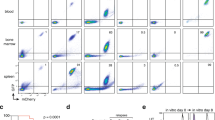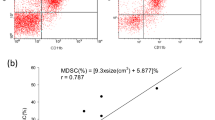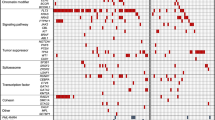Abstract
A population of human AML cells which have a characteristic karyotypic marker was cryopreserved and then grown in short-term liquid culture for 2 weeks, during which time the cells increased about 7-fold in number and progressively acquired characteristics of macrophages. 10(7) cells obtained after 1 day in culture, when they were almost devoid of Fc receptors (Fc-), on inoculation into immune-deprived mice gave rise to tumours in more than 90% of the animals. However, after 13 days of culture, when almost all the cells had Fc receptors (Fc+), a similar inoculum did not grow as tumours. After 7 days in culture the cells were heterogeneous, and divided about equally into Fc+ and Fc- cells, both of which were replicating. The Fc- population was capable of producing tumours, whereas the Fc+ was not. Of 23 assessable xenograft tumours produced by the AML cells, 14 regressed completely, 4 grew progressively and 5 grew progressively after initial regression. Progressive tumours could be further transplanted. The regression may arise as a result of maturation in vivo similar to that seen in vitro.
This is a preview of subscription content, access via your institution
Access options
Subscribe to this journal
Receive 24 print issues and online access
$259.00 per year
only $10.79 per issue
Buy this article
- Purchase on Springer Link
- Instant access to full article PDF
Prices may be subject to local taxes which are calculated during checkout
Similar content being viewed by others
Rights and permissions
About this article
Cite this article
Palú, G., Selby, P., Powles, R. et al. Spontaneous regression of human acute myeloid leukaemia xenografts and phenotypic evidence for maturation. Br J Cancer 40, 731–735 (1979). https://doi.org/10.1038/bjc.1979.253
Issue Date:
DOI: https://doi.org/10.1038/bjc.1979.253



